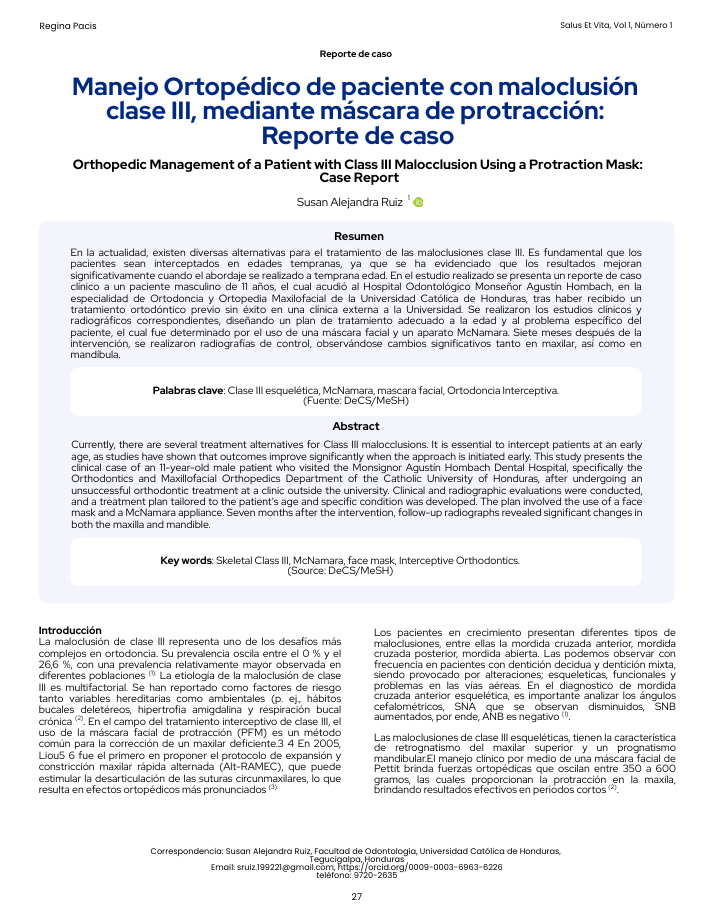Orthopedic Management of a Patient with Class III Malocclusion Using a Protraction Mask: Case Report

Published 2025-04-28
Keywords
- Skeletal Class III,
- McNamara,
- Face mask,
- Interceptive Orthodontics
Downloads
How to Cite

This work is licensed under a Creative Commons Attribution-NonCommercial-NoDerivatives 4.0 International License.
Abstract
Currently, there are several treatment alternatives for Class III malocclusions. It is essential to intercept patients at an early age, as studies have shown that outcomes improve significantly when the approach is initiated early. This study presents the clinical case of an 11-year-old male patient who visited the Monsignor Agustín Hombach Dental Hospital, specifically the Orthodontics and Maxillofacial Orthopedics Department of the Catholic University of Honduras, after undergoing an unsuccessful orthodontic treatment at a clinic outside the university. Clinical and radiographic evaluations were conducted, and a treatment plan tailored to the patient's age and specific condition was developed. The plan involved the use of a face mask and a McNamara appliance. Seven months after the intervention, follow-up radiographs revealed significant changes in both the maxilla and mandible.
References
- Ruiz López CdC. Corrección de mordida cruzada anterior con ortopedia. Rev Mex Ortod. 2015 oct-dic;3(4):239–244.
- Rodríguez Riquelme PE, Estrada Vitorino MA, Meneses López A. Tratamiento de la maloclusión Clase III con protracción maxilar: reporte de caso. Rev Estomatol Herediana [Internet]. 2017 oct 25 [citado 12 de noviembre de 2024];27(3):180. Disponible en: https://revistas.upch.edu.pe/index.php/REH/article/view/3202
- Sandoval P, Bizcar B. Beneficios de la implementación de ortodoncia interceptiva en la clínica infantil. Int J Odontostomat [Internet]. 2013 ago [citado 12 de noviembre de 2024];7(2):253 65. Disponible en: http://www.scielo.cl/scielo.php?script=sci_arttext&pid=S0718-381X2013000200016&lng=es. http://dx.doi.org/10.4067/S0718-381X2013000200016
- Arman A, Ufuk Toygar T, Abuhijleh E. Evaluation of maxi lary protraction and fixed appliance therapy in Class III patients. Eur J Orthod. 2006 Aug;28(4):383–92.
- edoya Rodríguez A, Osorio Patiño JC, Tamayo Cardona JA. Edad cronológica y maduración ósea cervical en niños y adolescentes. Rev Cubana Estomatol [Internet]. 2016 mar [citado 12 de noviembre de 2024];53(1):43–53. Disponible en: http://scielo.sld.cu/scielo.php?script=sci_arttext&pid=S0034-75072016000100006&lng=es
- Horta Sánchez CM, Parés Vidrio F. Manejo ortodóncico de la clase III. Rev ADM. 2020;77(1):41–5.
- Tochetto Primo B, Vanderlei Eidt S, Antonio Gregianin J, Antonio Primo N, Medeiros Faraco Junior I. Terapia da tração reversa maxilar com máscara facial de Petit – relato de caso. Rev Fac Odontol UPF [Internet]. 2010 nov 29 [citado 12 de noviembre de 2024];15(2). Disponible en: https://seer.upf.br/index.php/rfo/article/view/1353
- Martínez Smit R, DMJFaD. Maloclusión Clase III: diagnóstico y tratamiento ortopédico. Rev Cient Soc Ortod. 2016;3(2):7–17.
- Rivera Vásquez K, Vargas Rivera V, Palacios Vivar D, Siacar Bacarreza C. Uso del protocolo Alt-RAMEC combinado con mascari la facial como tratamiento de la maloclusión de clase III en pacientes en crecimiento: revisión de la literatura. Rev Latinoam Ortod Odontopediatr [Internet]. 2022 [citado 12 de noviembre de 2024]; Disponible en: https://www.ortodoncia.ws/publicaciones/2022/art-49/
- Jäger A, Braumann B, Kim C, Wahner S. Skeletal and dental effects of maxi lary protraction in patients with angle Class III malocclusion: a meta-analysis. J Orofac Orthop. 2001;62(4):275 84.
- Sarmiento-Cárdenas A. Cemento biocerámico como barrera apical en diente permanente no vital con ápice inmaduro. Odontol Act [Internet]. 2020 dic 30 [citado 12 de noviembre de 2024];6(1):51–8. Disponible en: https://oactiva.ucacue.edu.ec/index.php/oactiva/article/view/471
